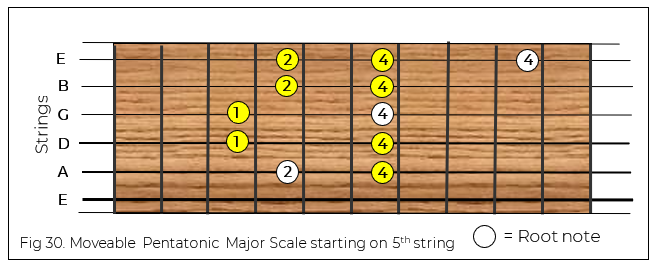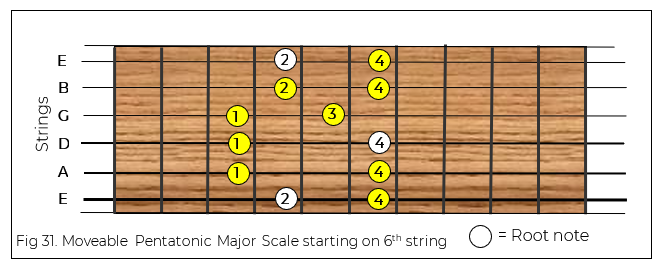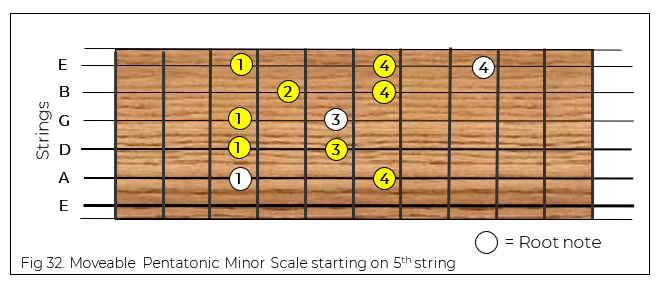There is a wide range of other scales around, all of which have different sounds and different applications. Here are a few of the more popular ones:
THE PENTATONIC SCALE
As the name suggests, this scale contains only five notes, and is used extensively in blues and rock music. It is a strong, powerful sounding scale and is great for blues, rock and pop leads. It can be major (with a major third) or minor (with a minor third).
PENTATONIC MAJOR STEP PATTERN:
| 1st | to | 2nd | = 1 tone | (2 frets) |
| 2nd | to | 3rd | = 1 tone | (2 frets) |
| 3rd | to | 4th | = 1+1/2 tones | (3 frets) |
| 4th | to | 5th | = 1 tone | (2 frets) |
| 5th | to | 6th | = 1+1/2 tones | (3 frets) |
So, in the key of A, we get:
| tone | tone | 1+1/2tone | tone | 1+1/2tone | ||||||||
| A | ^ | B | ^ | C# | ^ | E | ^ | F# | ^ | A | ||
| Frets: | 2 | 2 | 3 | 2 | 3 |
Listen:
FINGERING FOR ROOT NOTE ON 5TH STRING:
This pattern can be used when the root note of the natural minor scale falls anywhere on the 5th string.

FINGERING FOR ROOT NOTE ON 6TH STRING:
This pattern can be used when the root note of the natural minor scale falls anywhere on the 6th string.

PENTATONIC MINOR STEP PATTERN:
| 1st | to | 2nd | = 1+1/2 tones | (3 frets) |
| 2nd | to | 3rd | = 1 tone | (2 frets) |
| 3rd | to | 4th | = 1 tone | (2 frets) |
| 4th | to | 5th | = 1+1/2 tones | (3 frets) |
| 5th | to | 6th | = 1 tone | (2 frets) |
So, in the key of A, we get:
| 1+1/2tone | tone | tone | 1+1/2tone | tone | ||||||||
| A | ^ | C | ^ | D | ^ | E | ^ | G | ^ | A | ||
| Frets: | 3 | 2 | 2 | 3 | 2 |
Listen:
FINGERING FOR ROOT NOTE ON 5TH STRING:
This pattern can be used when the root note of the pentatonic scale falls anywhere on the 5th string.

FINGERING FOR ROOT NOTE ON 6TH STRING:
This pattern can be used when the root note of the pentatonic scale falls anywhere on the 6th string.

The pentatonic scale is used extensively in blues and rock music, to the point where it has become somewhat of a cliché. All the great blues guitar players use the pentatonic scale as a basis for lead work, simply playing the pentatonic scale appropriate to the key of the song. It is very effective over 12 bar blues-based music (see Chord Progressions).
Some players even combine the pentatonic major scale with it’s parallel pentatonic minor scale to create a blues ‘super scale’ (which contains eight notes, since both scales have the fourth note in common).
Remember to practice these scales in every position up and down the fingerboard.